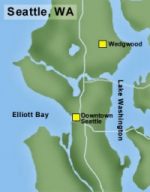
Wedgwood neighborhood in northeast Seattle. Map courtesy of HistoryLink.
In 1919 the Seattle School Board established a new program of “intermediate education” for grades 7, 8 and 9. Up until that time, elementary schools went through the eighth grade and high school was four years. One of the main reasons for creation of intermediate schools was to relieve crowding in the elementary schools.
In the 1920s there was strong population growth in the north Seattle neighborhoods of Green Lake and Wallingford, and these were the first in north Seattle to get separate intermediate schools. After the 1920s there were no more intermediate or high schools built in north Seattle until the 1950s, including Nathan Eckstein School at 3003 NE 75th Street in the Wedgwood neighborhood.
The school system struggled to keep up with population growth in the 1920s
The Seattle Public School System has always been a little behind the actual need of schools in response to population growth. Some of the reasons why there never seems to be enough space in school buildings is due to Washington State’s difficult tax structure and the feeling of some voters that they do not want to pay taxes for public services such as education. Before the Barefoot Schoolboy Law of 1895 which provided for government funding for schools, it was considered to be the responsibility of parents as to how much they wanted to pay for their children to be educated. Some parents did not want to pay tuition beyond the sixth or eighth grade and this is one of the reasons why Seattle had only one high school until after 1900.
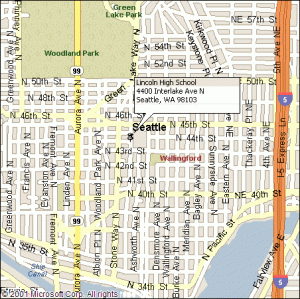
Location of Lincoln High School, Wallingford neighborhood in north Seattle.
Lincoln High School in Wallingford was the first high school to open in north Seattle, not including Ballard, which was still a separate city at that time and had its own school system. Lincoln opened in 1907 and was immediately overcrowded, and so was the next nearest high school, Queen Anne, which opened in 1909.
The overcrowding of the brand new high schools showed that parents and the young people themselves felt that there was value to high school education. However, when the school district proposed the opening of more high schools, some newspaper editors and public figures opposed the plans, causing delay, so that the next high school in north Seattle, Roosevelt, did not open until 1922.
In the 1920s the Seattle School Board had temporary buildings in the Green Lake and Wallingford areas for “overflow” of the area’s elementary schools which went through eighth grade. These two neighborhoods got the first intermediate-level buildings for grades 7, 8 and 9: John Marshall School at 520 NE Ravenna Boulevard on the east side of Green Lake, and Alexander Hamilton at 1610 N. 41st Street, about a block south of Lincoln High School in Wallingford. Both buildings opened in 1927.
After successful passage of bonds for funding, in 1927 the Seattle School Board announced a two-year building program. In a newspaper article in April 1927, it was explained that additions and expansions of existing buildings “will just about provide for the number of pupils now housed in portables or temporary buildings.” And, “when this building program is completed there will still be the problem of providing for the normal increase in school population.” In other words, the additions to existing buildings would not be enough and more new school buildings would still be needed. The writer of this news article added a subtle note of persuasion that the school building program would be good for the economy by providing jobs for laborers and profit for suppliers of building materials.
The future site of Nathan Eckstein School
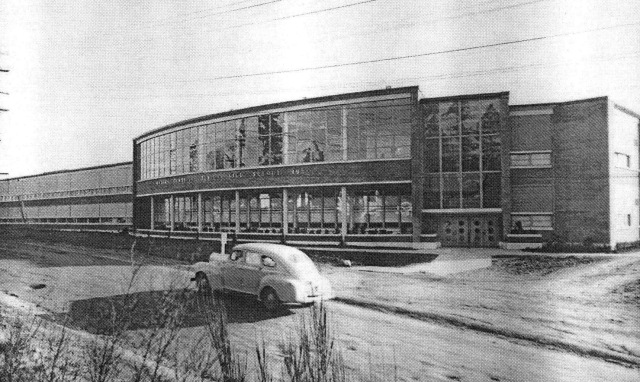
As shown here in 1954, four years after Eckstein School was built, NE 75th Street in front of the school still was not paved. Wedgwood was still a remote area of the city. Photo courtesy of Seattle Public Library Special Collections.
During the year of additions and expansion in 1927 the Seattle School Board purchased property which would become Nathan Eckstein School at 3003 NE 75th Street in Wedgwood, but the school would not become a reality until 1950. After the relatively prosperous period of the 1920s the USA went into a long economic slump during the 1930s, during which time money was not available for new schools. During the war years of the 1940s, all building plans were put on hold because materials of every kind were diverted to the war effort.
At the end of the 1940s some areas of north Seattle were still outside of the City Limits. The population was growing beyond 85th Street and new junior high schools were being built by the Shoreline School District: Woodrow Wilson on N. 90th Street in Licton Springs, and Jane Addams on NE 110th Street in Meadowbrook.
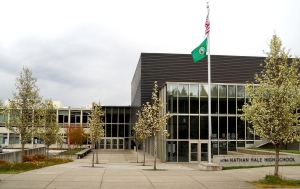
Nathan Hale High School at 10750 30th Ave NE in Meadowbrook (1963) is the last high school built in Seattle.
After Roosevelt High School opened in 1922, there were no more new high schools in north Seattle until Ingraham opened in 1959 and Nathan Hale in 1963. Existing schools in north Seattle began to be overcrowded again during the 1950s as children born after the end of World War Two, grew to high school age. Expansion of schools continued to face opposition from anti-tax groups who said that talk about the “baby boom” in the school-age population was just a “smoke screen” to cover up tax increases.
What was there before Eckstein School was built?
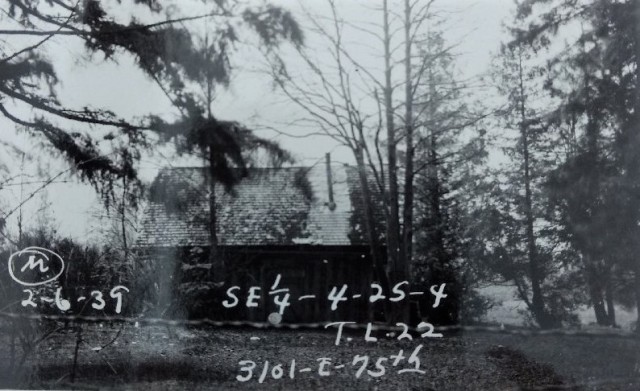
John Blomquist lived in this log house on the Eckstein School site.
The future site of Eckstein School had long been used as a pasture. The land owner was John Blomquist, a Swedish immigrant who had come to Seattle in the early 1900s. On the census of 1910 Blomquist listed himself as a farmer, and he probably did keep chickens and cows as many others in Wedgwood did in that time period. However, other work was needed to support oneself and Blomquist’s listings in the Seattle City Directory show that he held jobs such as driving a delivery wagon.
After the school property purchase in 1927, John Blomquist continued living on-site until such time as the school building plan would go ahead. As it turned out, Eckstein School was not built until after Blomquist’s death in 1945. Blomquist’s registration on the census of 1940 had said that at age 75 he was still working. His occupation at that time was “axe man,” working for a local real estate company to clear trees from building sites.

Capt. DeWitt C. Kenyon
The original homestead claimant of the Eckstein site was Capt. DeWitt C. Kenyon of Michigan, a Civil War veteran who came to Washington Territory in the 1870s. After the Civil War in the 1860s, many war veterans went out West to where land was still available and would be awarded to them for their service.
Capt. Kenyon and his wife Viola lived on their remote homestead claim in Wedgwood for a few years, as shown on the census of 1880. We don’t know exactly where on their claim property that they lived, as there were no site markers given on the census. The Kenyons owned property on both sides of NE 75th Street, and it is possible that they lived on what is now the Eckstein School property. A clue is that from very early years the site had been cleared of its trees, and by the time that John Blomquist lived there, the site was used as a pasture.
Later in the 1880s the Kenyons lived at Ninth & King Streets, east of present-day Pioneer Square in downtown Seattle. Capt. Kenyon worked at a wood products mill and Mrs. Kenyon was a schoolteacher until they moved to California in about 1888. Their property was then sold to Charles H. Baker but almost no one lived in what is now the Wedgwood neighborhood until after the year 1900, as the area was too remote.
The naming of Nathan Eckstein School
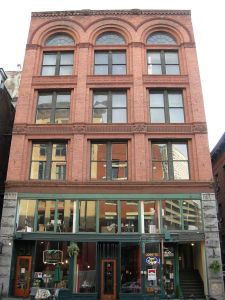
Schwabacher Building photo by Joe Mabel
The naming system for Seattle’s “intermediate” (junior high) schools was to choose names of outstanding American leaders. The name of a Seattle businessman and civic leader, Nathan Eckstein, was assigned to the new school in northeast Seattle which would open in 1950.
Nathan Eckstein was an immigrant from Bavaria in Germany. He spent ten years in the grocery business in New York City before coming to Seattle in 1898. He went to work for the Schwabacher Company which had been in Seattle since 1869, selling everything from groceries to hardware. During the Klondike Gold Rush of 1897-1898 the Schwabachers’ business boomed as they sold supplies to prospectors who were heading up north. Schwabacher’s at First & Yesler Streets in Seattle is a historic landmarked building under Seattle’s Historic Preservation Program.
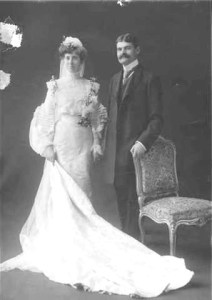
Nathan and Mina Eckstein wedding photo, 1902. Schwabacher collection photo number 1083.14, UW Special Collections.
In 1902 Nathan Eckstein married Mina, a daughter of one of the Schwabachers who, like Eckstein, were Jewish and who had come to America in search of religious freedom and economic opportunity.
Nathan Eckstein served in many charitable and civic activities in Seattle, including the School Board. He received the 1926 “Seattle’s Most Useful Citizen” award. Because of his outstanding contribution as a citizen of Seattle, his name was chosen for the school.
Bailey Gatzert, another outstanding civic leader who had married into the Schwabacher family, served as mayor of Seattle in 1875. An elementary school named for him is at Fourteenth & Yesler Streets.
Evolution of the intermediate schools
Over the time since intermediate schools were first established in Seattle in the 1920s, fluctuations in population have changed the grade levels which are included. Nathan Eckstein opened in 1950 as a junior high school which meant grades 7, 8 and 9.
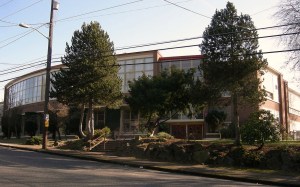
Nathan Eckstein Middle School. Photo by Joe Mabel.
In its first decade Eckstein’s enrollment peaked at 1,990 students which necessitated the addition of twenty portable classrooms.
In 1971 Eckstein became a middle school for grades 6, 7 and 8. In the decade beginning in the year 2010, school enrollment is again increasing and Eckstein has more than 900 students.
Sources:
“Building of Schools, Many School Projects.” Seattle Daily Times, April 17, 1927, page 28.
“Plea for School Expansion is Hit.” Seattle Daily Times, April 24, 1948, page 9.
Census and City Directory Listings for John Blomquist. The census can be accessed on-line through the Seattle Public Library website. City directories, which are like phone books but have more info, are available at the downtown Seattle Public Library on the 9th and 10th floors, and at the Municipal Archives in City Hall.
Property info: John Blomquist’s log house was inventoried in the King County survey in 1938-1939. These records are on file at the Puget Sound Regional Archives.
University of Washington Special Collections, Wedding portrait of Nathan and Mina Schwabacher Eckstein, 1902, Schwabacher photo collection number 1083.14.
Wikipedia essays: Nathan Eckstein; Schwabachers. Photos of Schwabachers Building and Eckstein Middle School courtesy of Joe Mabel, a Wedgwood neighborhood resident.
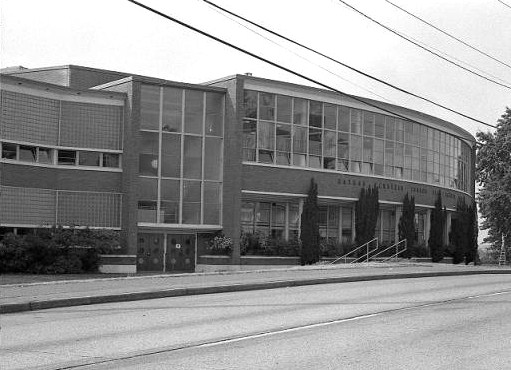
Eckstein School exterior circa 1984. Photo courtesy of Seattle Public Library Special Collections.

I love this article. Your research is impressive, and enjoyable to read. Would you consider during an article on the old elementary school, “Ravenna”, that is now a retirement center?
Thanks, Byron! I haven’t thought about writing about the old Ravenna School but you can read what the School District history site says about it — click on the “Seattle School Histories” link in my source list.
What a great write up!
Thanks, Alesia! I am still having fun with The Olden Days and searching out historic records. Don’t you just love our Civil War veteran in uniform, Capt. DeWitt C. Kenyon? Family descendants found my articles on-line and have contacted me, sharing photos.